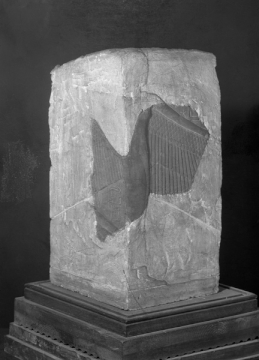Explore Collections


You are here:
CollectionsOnline
/
Part of the corner of a chest for canopic jars from the tomb of King Seti I
Browse
Part of the corner of a chest for canopic jars from the tomb of King Seti I
XIXth Dynasty
Alabaster, probably, covered in paint or discoloured varnish
Height: 20cm
Width: 17cm
Depth: 9cm
Width: 17cm
Depth: 9cm
Museum number: X74
On display: Sepulchral Chamber
All spaces are in No. 13 Lincoln's Inn Fields unless identified as in No. 12, Soane's first house.
For tours https://www.soane.org/your-visit
Curatorial note
To the right: body of left arm of a goddess (Neith or Nephthys). The goddess is clothed in the tight-fitting dress of the usual type, fastened with a band below the breast, and held in place by a double strap over the shoulder. From the outstretched arm depends a wing, which probably crossed the wing of a similar figure at the next corner, thus affording complete protection to that side of the chest. The goddess wears a bracelet on the upper part of the arm, of the same type as the bead-bracelets which are seen in the scenes on the temple sculptures. There are traces of a wide necklace. Above the arm of the goddess are the remains of two vertical lines of inscription reading from right to left.
The text is perhaps the beginning of the name of Dua-mut-ef, one of the four gods of the cardinal points of the compass, who protect the viscera of the dead person contained in the Canopic jars.
To the left: The winged right arm of the goddess (or possibly of another figure) is stretched out. Below the wing is a hand hanging down from under the wing which, from its position, does not appear to belong to the goddess.
To the right of the hand under the wing is one maa-kheru 'True of voice' (see above paragraph), an epithet always placed after the name of a deceased person. Below the inscription are the ends of three pinion-feathers belonging to the winged figure at the next corner.
The text is perhaps the beginning of the name of Dua-mut-ef, one of the four gods of the cardinal points of the compass, who protect the viscera of the dead person contained in the Canopic jars.
To the left: The winged right arm of the goddess (or possibly of another figure) is stretched out. Below the wing is a hand hanging down from under the wing which, from its position, does not appear to belong to the goddess.
To the right of the hand under the wing is one maa-kheru 'True of voice' (see above paragraph), an epithet always placed after the name of a deceased person. Below the inscription are the ends of three pinion-feathers belonging to the winged figure at the next corner.
This piece entered Soane's collection as one of the pieces of the lid of the sarcophagus of Seti I in 1824 and was illustrated as such by J.M. Gandy in his watercolour record of the lid fragments, made in c.1824-25 (SM Vol. XX) and so must have been acquired via Mr. Henry Salt with the other fragments (see Sir John Soane's Museum object file).1
1 Its inclusion in this volume was discovered by Helen Dorey and confirms the thesis of Aidan Dodson.
Literature
Aidan Dodson, 'A Fragment of a Canopic Chest in Sir John Soane's Museum', The Journal of Egyptian Archaeology 71, 1985, pp. 177-179, pl. XIX.
H. Jenni (ed.), Das Grab Ramses' X (KV 18), Basel 2000, pp. 69-71, fig. 58, 59.
Aidan Dodson, ‘Some Additional Notes on “A Fragment of Canopic Chest in Sir John Soane’s Museum,” JEA 71 (1985), 177-79’, Discussions in Egyptology 4 (1986): 27-8
H. Jenni (ed.), Das Grab Ramses' X (KV 18), Basel 2000, pp. 69-71, fig. 58, 59.
Aidan Dodson, ‘Some Additional Notes on “A Fragment of Canopic Chest in Sir John Soane’s Museum,” JEA 71 (1985), 177-79’, Discussions in Egyptology 4 (1986): 27-8
Associated items
Soane collections online is being continually updated. If you wish to find out more or if you have any further information about this object please contact us: worksofart@soane.org.uk







